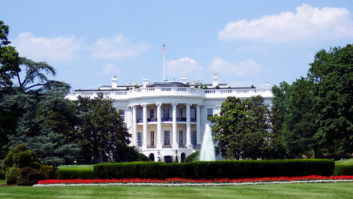The consensus of Capitol Hill observers is that efforts to earn congressional approval of the AM Radio for Every Vehicle Act has built momentum in recent weeks by gaining support from additional members of Congress.
Also, a Senate committee is reporting favorably on the bill. The legislation, which was advanced by the Senate Commerce Committee in February, seeks to ensure that AM broadcast radio remains a standard feature in new vehicles.
Radio World reviewed a report on the proposed mandate that was originally released in April from the Senate Committee on Commerce, Science and Transportation.

The committee, chaired by Sen. Ted Cruz (R-Texas), believes the decision by some automakers to remove broadcast AM radio from vehicles presents a public safety concern.
[Related: “House Majority Backs AM Radio Mandate”]
The legislation directs the U.S. Department of Transportation to issue a rule requiring AM broadcast radio — analog or digital — to be included in all new passenger vehicles at no additional costs to consumers. If signed into law, DOT would have 12 months to issue the rule. Automakers in most cases would have several years to adhere to the new mandate.
Cost analysis for regulators and automakers
The Senate committee’s report included a cost estimate prepared by the Congressional Budget Office that said the mandate will be inexpensive for the government to implement, without being economically burdensome for automakers, which includes producers of electric vehicles.
“Based on sales data for EVs, the legislation would require manufacturers to update radio equipment in about 2 to 2.5 million vehicles each year,” CBO Director Phillip Swagel said in the report. “Since most EVs are already equipped with FM radio, this would likely result in a small increase in production costs to update the media system software and modify other radio components.”
The CBO in the report estimated the total cost to automakers of the mandate would be “several millions of dollars each year the requirement is in effect.” OEMs could face possible fines for violations. The private sector mandate, if it becomes law, would sunset after 10 years.
Federal implementation, according to the CBO, will cost about $1 million over five years. The report said it expects limited revenue from “enforcement actions for noncompliance.” It estimated that less than $500,000 will be collected in penalties from automakers during the bill’s 10-year horizon with few violations.
FEMA’s Primary Entry Points
The Senate Committee believes the decision by OEMs to remove broadcast AM radio from vehicles “presents a public safety concern,” given the federal investments in upgrading and equipping FEMA’s Primary Entry Point stations, as well as the role those stations play in the Integrated Public Alert and Warning System.
The committee noted 86% of FEMA’s 72 PEP stations in the U.S. are AM stations, which are used for emergency alerts that are then retransmitted to other electronic media. The role AM radio stations serve during times of disaster and emergency response, the report said, makes them critical to “domestic emergency management.”
At the same time, the committee is sensitive to the fact that technology evolves over time, which may impact the need to the mandate. To address that possibility, the legislation directs the Government Accountability Office to study the advantages, effectiveness, limitations, resilience and accessibility of IPAWS via AM radio or other technologies in motor vehicles.
The CBO said in the report there might another benefit to the AM requirement. “As a result of the legislation, some manufacturers may elect to make other modifications to the vehicle as well to improve audio quality,” according to the report.
Where the legislation stands
The radio industry has rallied against the move by some automakers to eliminate AM radio.
The OEMs say the cost of mitigating electromagnetic interference to AM radios in electric vehicles is prohibitive. The auto industry has also cited less of a need for AM radio due to evolving listener habits in the car. Other critics of the bill, including the Consumer Technology Association, have said they believe consumers can also lean on new technologies to receive emergency alerts.
The bill includes language that would also prohibit future phase-outs in other vehicles where AM radio is already standard, including gas and diesel powered. The legislation would mandate AM capability in new vehicles made and sold in the United States, as well as vehicles manufactured abroad that are sold in the U.S.
The legislation has already passed the Senate Commerce Committee and is waiting on consideration by the full Senate. The companion bill (H.R. 979) in the House of Representatives now has a simple majority of co-sponsors, but it is still awaiting action by a house committee.







